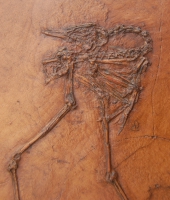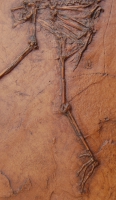
In spite of the fact that most of the prehistoric Messel area was covered by lakes, typical waterfowl (like ducks) are seldom found. Only a single specimen of a bird which was clearly adapted to water life has been found to date. The most common bird found a Lake Messel is the lakeshore inhabitant Messelornis cristata or "Messel rail."
The Messel Pit is a no longer used quarry near the village of Messel which is located about 35 km south east of Frankfurt, Germany. The quarry was used to mine bituminous shale. On December 9, 1995, the Messel Pit was declared a World Heritage site by UNESCO. The Messel Pit has been known for its fossils since about 1900, but was not seriously excavated for scientific study until the 1970's. The Messel Pit was closed to collecting in 1974. Therefore, only specimens collected before that date are available to the market today.
Fifty million years ago, during the Geiseltalion Period, the Messel area was covered by a large series of lakes which were surrounded by lush sub-tropical forest that supported and incredibly diverse variety of life forms. The oil shale, present today, was created by the slow decomposition of dead vegetation in an anoxic environment combined with the fine-grained sediments which accumulated at the bottom of these lakes. Because the plants and animals were deposited at the bottom of these lakes where there was little or no oxygen present, very little disturbance or scavenging would have taken place. This, along with the fine-grained sediments, led to the excellent preservation of complete skeletons, including skin, fur, and feathers in some cases.
It is believed that the Messel Pit area was geologically active during the Eocene. Subsurface shifts may have periodically released concentrations of gases (carbon dioxide and hydrogen sulfide) into the lake and surrounding areas, overwhelming and killing any animals which were near.
You will find that nearly all specimens from Messel, Germany will be encased in epoxy, resin, or Lucite. This is due to the fact that the shale layers that the fossils are found in are made up of about 40% water and 8% oil. When the water evaporates, the shale and the fossils become very unstable and they turn to powder. They are stabilized with epoxy, to prevent this decomposition, and later as time permits, they are encased in resin or Lucite.
The original specimen that this replica was cast from is from a private collection and is not available for sale!
resin
9 x 11-1/2 x 3/4
Item 3148
Category: Replicas
Type: Skeletons
Phylum: Vertebrates
Class: Amphibians
MORE PHOTOS:




Now Over 1,000 Items!
PrehistoricStore.com offers the largest selection of replica fossils and other fossil-related products anywhere in the world!
Download a Full Catalog (3MB PDF)
OVER 260 PAGES OF REPLICAS AND MORE!
